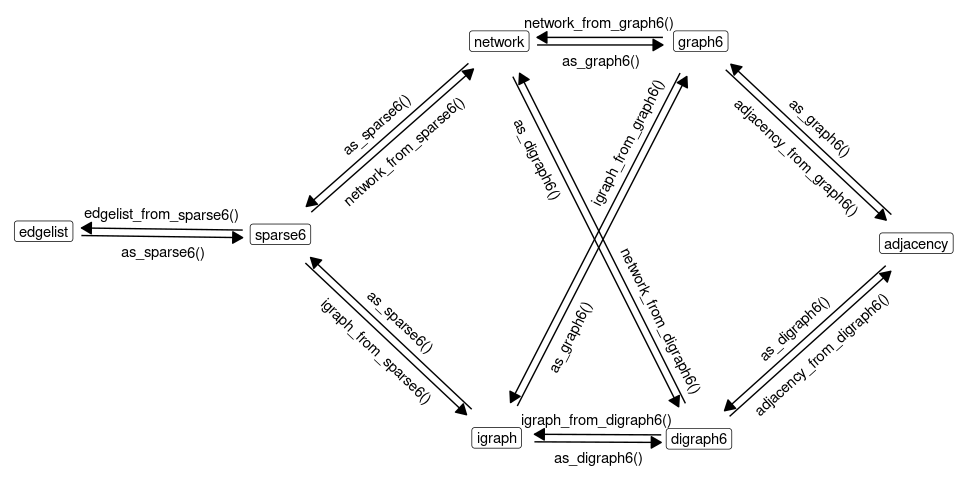rgraph6:
Representing Graphs as graph6, digraph6 or sparse6 Strings

rgraph6:
Representing Graphs as graph6, digraph6 or sparse6 Strings

Functions in this package allow for encoding network data as strings of printable ASCII characters and back using ‘graph6’, ‘sparse6’, and ‘digraph6’ formats. This is convenient in a number of contexts, especially when working with large number of graphs. Provided functions allow to directly encode and decode graph data in the form of adjacency matrices, edgelists, network objects and igraph objects to and from these three formats.
‘graph6’, ‘sparse6’ and ‘digraph6’ are formats for encoding graphs as strings of printable ASCII characters due to Brendan McKay. See here for format specification. Formats ‘graph6’ and ‘sparse6’ are for undirected graphs. Format ‘digraph6’ is for directed graphs.
Main functions for encoding network data are:
as_graph6()as_sparse6()as_digraph6()Main functions for decoding are:
adjacency_from_text()edgelist_from_text()igraph_from_text()network_from_text()Low-level functions are shown on the following graph:

Generate a list of igraph objects:
set.seed(666)
igraph_list <- replicate(5, igraph::sample_gnp(10, 0.1, directed = FALSE),
simplify = FALSE
)Encode as ‘graph6’ symbols:
as_graph6(igraph_list)
#> [1] "ICG_@?W??" "I????@B?G" "I?@O????W" "I@@A?E???" "I?_?_@_??"Encode as ‘sparse6’ symbols:
as_sparse6(igraph_list)
#> [1] ":IeASjaeR" ":IoCp{^" ":IiC]Rg" ":IeIgWu`" ":IgAo{@D"Using example data g6, d6, and
s6 provided with the package:
# Create a vector with a mixture of 'graph6', 'digraph6' and 'sparse6' symbols
x <- c(g6[1], s6[2], d6[3])
x
#> [1] "N??E??G?e?G?????GGO"
#> [2] ":NkF?XduSqiDRwYU~"
#> [3] "&N?R_?E?C?D??U_A????????O???????????????"
# Parse to igraph objects (package igraph required)
igraph_from_text(x)
#> [[1]]
#> IGRAPH 4a2f1fa U--- 15 10 --
#> + edges from 4a2f1fa:
#> [1] 1-- 7 1--11 2-- 7 2--11 2--12 2--15 5-- 9 7--10 8--15 13--15
#>
#> [[2]]
#> IGRAPH f21cde8 U--- 15 13 --
#> + edges from f21cde8:
#> [1] 2-- 7 2-- 9 4--10 6--10 6--12 7--12 11--12 5--13 6--13 10--13
#> [11] 4--15 10--15 14--15
#>
#> [[3]]
#> IGRAPH 67f19fc D--- 15 15 --
#> + edges from 67f19fc:
#> [1] 1-> 8 1->11 1->12 1->13 2->13 2->14 3->10 4-> 7 4-> 9 5-> 8 5->10 5->11
#> [13] 5->13 6-> 8 9->14
# Parse to network objects (package network required)
network_from_text(x)
#> Loading required namespace: network
#> [[1]]
#> Network attributes:
#> vertices = 15
#> directed = FALSE
#> hyper = FALSE
#> loops = FALSE
#> multiple = FALSE
#> bipartite = FALSE
#> total edges= 10
#> missing edges= 0
#> non-missing edges= 10
#>
#> Vertex attribute names:
#> vertex.names
#>
#> No edge attributes
#>
#> [[2]]
#> Network attributes:
#> vertices = 15
#> directed = FALSE
#> hyper = FALSE
#> loops = FALSE
#> multiple = FALSE
#> bipartite = FALSE
#> total edges= 13
#> missing edges= 0
#> non-missing edges= 13
#>
#> Vertex attribute names:
#> vertex.names
#>
#> No edge attributes
#>
#> [[3]]
#> Network attributes:
#> vertices = 15
#> directed = TRUE
#> hyper = FALSE
#> loops = FALSE
#> multiple = FALSE
#> bipartite = FALSE
#> total edges= 15
#> missing edges= 0
#> non-missing edges= 15
#>
#> Vertex attribute names:
#> vertex.names
#>
#> No edge attributesThe formats shine if we need to store large number of graphs in a data frame. Let’s generate a list of random graphs as igraph objects and store them in a data frame column of graph6 symbols:
library("dplyr")
# Generate list of igraph objects
set.seed(666)
d <- tibble::tibble(
g6 = replicate(
10,
igraph::sample_gnp(sample(3:12, 1, replace = TRUE), p = .5, directed = FALSE),
simplify = FALSE
) %>%
as_graph6()
)
d
#> # A tibble: 10 × 1
#> g6
#> <chr>
#> 1 FSOT_
#> 2 JYNALTg{fE?
#> 3 JWwbmJNOfX_
#> 4 Gr|Kto
#> 5 IftZ~cXPo
#> 6 H`i@]us
#> 7 FClsO
#> 8 IlPd`~fbg
#> 9 BG
#> 10 GFnwpWNice and compact. We can go further by doing some computations and saving the results together with the graph data, and even save it to a simple CSV file!
d %>%
dplyr::mutate(
igraphs = igraph_from_text(g6),
vc = purrr::map_dbl(igraphs, igraph::vcount),
ec = purrr::map_dbl(igraphs, igraph::ecount),
density = purrr::map_dbl(igraphs, igraph::edge_density)
) %>%
dplyr::select(-igraphs) %>%
write.csv(row.names = FALSE)
#> "g6","vc","ec","density"
#> "FSOT_",7,7,0.333333333333333
#> "JYNALTg{fE?",11,26,0.472727272727273
#> "JWwbmJNOfX_",11,28,0.509090909090909
#> "Gr|Kto",8,17,0.607142857142857
#> "IftZ~cXPo",10,27,0.6
#> "H`i@]us",9,17,0.472222222222222
#> "FClsO",7,9,0.428571428571429
#> "IlPd`~fbg",10,26,0.577777777777778
#> "BG",3,1,0.333333333333333
#> "GFnwpW",8,16,0.571428571428571Install development version from GitHub with:
# install.packages("remotes")
remotes::install_github("mbojan/rgraph6", build_vignettes = TRUE)Nightly Windows and MacOS binaries are available on R Universe:
install.packages("rgraph6", repos = "https://mbojan.r-universe.dev")Author and maintainer: Michal Bojanowski michal2992@gmail.com (https://orcid.org/0000-0001-7503-852X, Kozminski University).
Co-authors: David Schoch (https://orcid.org/0000-0003-2952-4812)
To cite this package please use the following two entries:
Bojanowski M, Schoch D (2024). rgraph6: Representing Graphs as ‘graph6’, ‘digraph6’ or ‘sparse6’ Strings. R package version 2.0-4, https://mbojan.github.io/rgraph6/.
McKay, B. D., & Piperno, A. (2014). Practical graph isomorphism, II. Journal of Symbolic Computation, 60, 94-112.